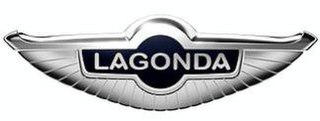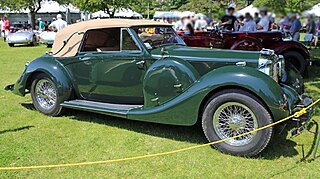
Vanden Plas is the name of coachbuilders who produced bodies for specialist and up-market automobile manufacturers. Latterly the name became a top-end luxury model designation for cars from subsidiaries of British Leyland and the Rover Group, last used in 2009 to denote the top-luxury version of the Jaguar XJ (X350).

The Aston Martin Lagonda is a full-size luxury four-door saloon manufactured by British manufacturer Aston Martin between 1974 and 1990. A total of 645 were produced. The name was derived from the Lagonda marque that Aston Martin had purchased in 1947. There are two distinct generations, the original, the short lived 1974 design based on a lengthened Aston Martin V8, and the entirely redesigned, wedge-shaped Series 2 model introduced in 1976.

Berkeley Cars Ltd of Biggleswade, Bedfordshire, England produced economical sporting microcars with motorcycle-derived engines from 322 cc to 692 cc and front wheel drive between 1956 and 1960.

Walter Owen Bentley, MBE was an English engineer who founded Bentley Motors Limited in London. He was a motorcycle and car racer as a young man. After making a name for himself as a designer of aircraft and automobile engines, Bentley established his own firm in 1919. He built the firm into one of the world's premier luxury and performance auto manufacturers, and led the marque to multiple victories at the 24 Hours of Le Mans. After selling his namesake company to Rolls-Royce Limited in 1931, he was employed as a designer for Lagonda, Aston Martin, and Armstrong Siddeley.

L'Aster, Aster, Ateliers de Construction Mecanique l'Aster, was a French manufacturer of automobiles and the leading supplier of engines to other manufacturers from the late 1890s until circa 1910/12. Although primarily known as an engine mass manufacturer the company also produced chassis for coach-works and a complete range of components.

The Atalanta was an English automobile manufactured from 1937 until 1939 by Atalanta Motors Ltd in Staines, Middlesex. Two models were made.

Sunbeam Motor Car Company Limited was a British motor car manufacturer with its works at Moorfields in Blakenhall, a suburb of Wolverhampton in Staffordshire, now West Midlands. Its Sunbeam name had been registered by John Marston in 1888 for his bicycle manufacturing business. Sunbeam motor car manufacture began in 1901. The motor business was sold to a newly incorporated Sunbeam Motor Car Company Limited in 1905 to separate it from Marston's pedal bicycle business; Sunbeam motorcycles were not made until 1912.

The Austin 7 is an economy car that was produced from 1923 until 1939 in the United Kingdom by Austin. It was nicknamed the "Baby Austin" and was at that time one of the most popular cars produced for the British market and sold well abroad. Its effect on the British market was similar to that of the Model T Ford in the US, replacing most other British economy cars and cyclecars of the early 1920s. It was also licensed and copied by companies all over the world. The first BMW car, the BMW Dixi, was a licensed Austin 7. In France they were made and sold as Rosengarts, and in the United States they were built by the American Austin Car Company. In Japan, Nissan also used the 7 design as the basis for their first cars, although not under licence. This eventually led to a 1952 agreement for Nissan to build and sell Austins in Japan under the Austin name.

Lagonda is a British luxury car brand established in 1906, which has been owned by Aston Martin since 1947. The trade-name has not had a continuous commercial existence, being dormant several times, most recently from 1995 to 2008 and 2010 to 2013.

The Bentley R Type is the second series of post-war Bentley automobiles, replacing the Mark VI. Essentially a larger-boot version of the Mk VI, the R type is regarded by some as a stop-gap before the introduction of the S series cars in 1955. As with its predecessor, a standard body was available as well as coachbuilt versions by firms including H. J. Mulliner & Co., Park Ward, Harold Radford, Freestone and Webb, Carrosserie Worblaufen and others.
Morris Cowley was a name given to various cars produced by Morris from 1915 to 1958.

The Squire Car Manufacturing Company was a British auto manufacturer of the 1930s, based in Henley-on-Thames, Oxfordshire. It was founded as Squire Motors Ltd by 21-year-old Adrian Squire (1910–1940), formerly of Bentley and MG. Renamed as the Squire Car Manufacturing Company it produced the Squire car, which epitomised the Grand Prix car turned into road car.

British Salmson was a British based manufacturer of cars, from 1934 to 1939. An offshoot of the French Salmson company, it was taken over by local management. After producing war supplies during World War II, it ceased car production, moved to Glasgow, Scotland, and produced printing machinery.
Abbott of Farnham, E D Abbott Limited was a British coachbuilding business based in Farnham, Surrey, trading under that name from 1929. A major part of their output was under sub-contract to motor vehicle manufacturers. The business closed in 1972.

Frank Gerald Feeley, born in Staines-upon-Thames on 16 January 1912, was an automotive stylist and designer. He joined Lagonda based in Staines, where his father, Jeremiah Feeley, also worked, straight from school as an office boy under Arthur Thatcher, the assistant works manager responsible for coachbuilding. He went on to work for Walter Buckingham who was in charge of body design and when the Lagonda Rapier was introduced in 1933 Feeley designed a four-seat tourer body for the demonstrator.

The Lagonda V12 is a large car produced by the British Lagonda company from 1938 to 1940. It was first shown at the 1936 London Motor Show but production did not commence until 1938.
The Enfield-Allday was an English car manufactured in Sparkbrook, Birmingham, from 1919 to 1924. The marque was created from the merged ranges of Alldays & Onions and Enfield and the Enfield Autocar Co Ltd.
John Charles & Co was a British coachbuilding company founded in 1932 and based initially near Kew Gardens, London.

The Lagonda LG6 is a large car produced by the British Lagonda company from 1937 to 1940. It was announced at the 1937 London Motor Show.

The Lagonda 14/60 was a sports touring car introduced by Lagonda in 1925. Production of the 14/60 continued until 1931. As well as the standard car there were variants called the 2 Litre Speed (1927–33) and Continental.


















